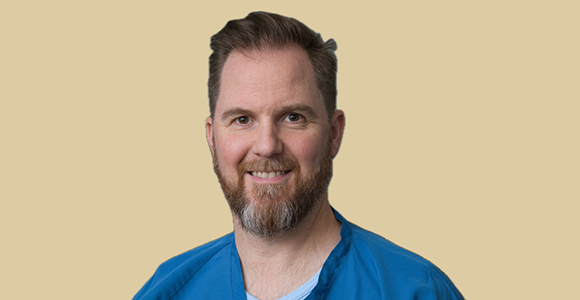Meet our researchers
Meet our researchers: Bjarke Viberg
Bjarke Viberg is a professor at the Department of Clinical Research and serves as Denmark's only professor of orthopaedic surgical traumatology. His focus is on the treatment of fractures in arms and legs. He is dedicated to providing the best treatment for the approximately 100,000 Danes who break their arms or legs each year.
Why did you choose to become a researcher?
Out of curiosity and a passion for optimization! I've always been intrigued by the prospect of learning new things, expanding my knowledge in a field, or experiencing something novel. This innate curiosity has always been paired with a motivation to enhance things, ranging from optimizing everyday activities like brushing teeth and styling hair to refining surgical procedures and patient care.
Curiosity prompted me to question whether we are performing tasks adequately, and I believe it's crucial to offer the best possible patient care. I have the chance to optimize treatment through research and to investigate new treatment methods. This is likely why I chose to become a researcher.
What other career paths did you consider?
As a child, like many others, I considered becoming a police officer or firefighter. In fact, I worked as a part-time firefighter at the Odense Fire Department while studying to become a chiropractor.
Four years into my chiropractic studies, the appeal of the flashing blue lights from the fire department, combined with a curiosity to learn more, led me to switch to medical studies.
The foundational aspects of the urgent nature of firefighting, along with the hands-on experience gained from chiropractic studies, guided me toward orthopedic surgery, with a specialization in treating broken arms and legs.
What is your current focus?
How can we provide the best possible treatment to patients?
This significant question has the potential to fuel my research and curiosity for the rest of my life, serving as a major source of motivation: Who benefits from surgery and who does not? How can we ensure the best possible collaboration across different sectors to provide patients with the most optimal treatment journey? What are the most effective methods for data collection to enhance our understanding of the treatments we offer to patients? These are among the questions that preoccupy me the most.
Which question would you most like to answer?
Haha, if I could choose freely, I would like to discover the meaning of life.
Or, more specifically related to my field, it would be to find a way to accelerate the healing process for bone fractures. Although this isn't directly my area of expertise, I would be extremely satisfied if I could contribute to ensuring that the right treatment is given to the right patient.
What has been the greatest breakthrough in your field to date?
Thinking historically, we must look far back for the major breakthroughs. More than a thousand years ago, all bone fractures were treated with some form of support around an arm or leg, such as wooden sticks or a precursor to what we recognize today as plaster casts.
In the 1860s, the English surgeon Joseph Lister introduced the concept of aseptic surgery, and along with concurrent advances in anesthesia, it became possible to undertake more complex surgical procedures.
Within the field of treating broken arms and legs, a significant breakthrough occurred at the beginning of the 20th century with the introduction of metal splints being inserted into the bone. Another major advancement came in the mid-20th century when there was an increased understanding of bone healing.
Why is your field of research important?
In Denmark, roughly 100,000 arms or legs are fractured annually, with surgeries conducted on about 15,000 of these cases. Although the success rate is high, there remains a significant minority, approximately 10%, who suffer from non-healing fractures, chronic pain, or diminished function. Therefore, it is imperative that we prioritize offering the optimal initial treatment to reduce the incidence of post-treatment complications.
The field of fractures, particularly broken arms and legs, typically lacks advanced research. For example, I've spearheaded the inaugural national study on hip fractures, serve as a senior researcher on the most extensive Scandinavian multicenter study examining fractured humeri, and am a member of the steering committee for pediatric wrist fractures. Through these initiatives, our goal is to discover the most effective ways to treat our patients, regardless of their age, from 4 to 89 years old.
How do you hope others can benefit from your research?
I hope that my research can assist other orthopedic surgeons in enhancing their treatment of broken arms and legs.
Which other research field fascinates you the most?
My curiosity leads me to find many other fields of research intriguing. This includes areas that intersect with my own, such as geriatric medicine and osteoporosis, but I also find basic research to be particularly exciting.
What do you have in your office that most people do not?
I have old metal splints, nails, and screws that were used in surgeries for broken arms and legs. Additionally, my office is filled with numerous empty soda bottles since I don't drink coffee.
Who do you admire the most?
I don't have anyone specific in mind, as I'm consistently drawn to individuals who are passionate about their pursuits. If I had to choose, it would likely be my wife for her incredible patience and ability to tolerate me.
What do you do in your free time when you're not engaged in research?
Much of my free time is dedicated to research, as it doubles as a hobby for me, but I also make time for exercise and playing padel.
In addition, I enjoy DIY projects around the house and am particularly excited about building a wooden terrace once the weather improves.
On a daily basis, I always look forward to having dinner with my wife and our three daughters.
Meet the researcher
Professor Bjarke Viberg, Department of Clinical Research, Research Unit of Orthopedic Surgery.
